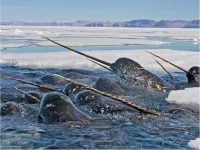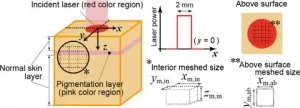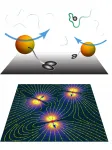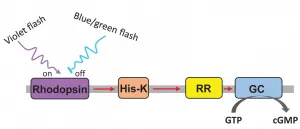(Press-News.org) In the Arctic, climate change and pollution are the biggest threats to top predators like narwals. Studying the animals' tusks reveals that diet and exposure to pollution have shifted over the past half century in response to sea-ice decline. Human emissions have also led to a sharp rise in the presence of mercury in recent years, according to an international team of researchers.
"Our research shows that climate change is having substantial impacts on Arctic ecosystems, with consequences for exposure to toxic pollutants like mercury," says co-author Jean-Pierre Desforges, a Postdoctoral Fellow at McGill University under the supervision of Nil Basu and Melissa McKinney.
Using natural growth layers in the tusk of male narwhals, the researchers were able to document yearly changes in mercury exposure dating back to the 1960s in a study published in Current Biology.
The narwhals' unicorn-like tusk projects from the left side of the upper jaw of the males and can reach up to three metres long. Just like rings in a tree trunk, every year a new growth layer is added to the narwhal's tusk.
Because the tusk is connected to the rest of body through blood, each new layer records aspects of the animal's physiology, the researchers explain. This includes information on what and where the animals have eaten each year and exposure to contaminants from human activity.
You are what you eat
"Heavy metals like mercury and other contaminants accumulate at each link in the food chain. The higher you are in the food chain, the more mercury you accumulate in your body throughout your life," says Desforges. Elevated amounts of heavy metals in the body are toxic and can affect cognitive functions, behaviour, and the ability to reproduce.
The researchers found that from 1990 until 2000, narwhals accumulated relatively small quantities of mercury as the new prey sat lower in the food chain. Up until around 1990, the narwhals' food consisted particularly of prey linked to the sea ice, such as halibut and Arctic cod. During this period, the ice cover was extensive in areas like Baffin Bay.
After 1990, the ice cover declined consistently year after year and the diet of the narwhals changed to open ocean prey like capelin and polar cod. However, from around 2000, the amount of mercury increased significantly in the narwhal tusks without a simultaneous shift in diet.
Impact of climate change
The researchers attribute the rise in mercury emissions to on-going fossil fuel combustion in South-East Asia. The increase could also be due to changing sea ice conditions as the climate warms, causing changes in the environmental mercury cycle in the Arctic.
Over the past 30 to 40 years, climate change has reduced sea ice cover in the Arctic. Many species depend on the ice to evade predators and in their search for food or important breeding grounds. This affects the entire Arctic food chain and the living conditions of all species.
Changes in temperature and sea ice also lead to invasion by new species from warmer areas. For the narwhal, the ice acts as a protection against enemies like killer whales, they say.
"The narwhal is one of the Arctic mammals most affected by climate change. They lack the physiological properties that help eliminate environmental contaminants. They can't get rid of mercury by forming hair and feathers like polar bears, seals, or seabirds," explains co-author Professor Rune Dietz from the Department of Bioscience at Aarhus University in Denmark.
A window into Arctic conditions
The findings show that each layer of the narwal tusk offers valuable information on the animals' living conditions and a window into developments in the Arctic.
"With our discovery, we now know that there's a bank of data in the narwhal tusks found in museums around the world. By analysing them, we can hopefully get insight into the narwhals' food strategy from different periods. This will provide us with a solid basis for evaluating how the species copes with the changing conditions that it encounters today in the Arctic," says Dietz, who is also affiliated with Aarhus University's Arctic Research Centre.
INFORMATION:
About this study
"Analysis of narwhal tusks reveals lifelong feeding ecology and mercury exposure" by Rune Dietz, Jean-Pierre Desforges, Frank F. Riget, Aurore Aubail, Eva Garde, Per Ambus, Robert Drimmie, Mads Peter Heide-Jorgensen, and Christian Sonne was published in Current Biology.
DOI: https://doi.org/10.1016/j.cub.2021.02.018
About McGill University
Founded in Montreal, Quebec, in 1821, McGill University is Canada's top ranked medical doctoral university. McGill is consistently ranked as one of the top universities, both nationally and internationally. It?is a world-renowned?institution of higher learning with research activities spanning two campuses, 11 faculties, 13 professional schools, 300 programs of study and over 40,000 students, including more than 10,200 graduate students. McGill attracts students from over 150 countries around the world, its 12,800 international students making up 31% of the student body. Over half of McGill students claim a first language other than English, including approximately 19% of our students who say French is their mother tongue.
https://www.mcgill.ca/newsroom/
Alexandria, Va., USA -- Asymptomatic carriage of SARS-CoV-2 is a potentially significant source of transmission, yet remains relatively poorly understood. The study "SARS-CoV-2 Positivity in Asymptomatic-screened Dental Patients" published in the Journal of Dental Research (JDR), investigated SARS-CoV-2 infection in asymptomatic dental patients to inform community surveillance and improve understanding of risks in the dental setting.
Thirty-one dental care centers across Scotland invited asymptomatic screened patients over the age of five to participate. During the patient visit, trained ...
Laser treatment is now commonplace across various fields of medicine including dermatology, where it is commonly used to remove scars, wrinkles, and freckles. The technology, however, has a major downside: despite continued improvements, medical accidents related to laser treatment has been on the rise, with studies revealing excessively high laser energy as the major cause of such accidents.
Assistant Professor Takahiro Kono from Shibaura Institute of Technology (SIT), Japan, whose research is focused on the mechanism of heat transfer involved in the interaction of laser light with biological tissue explains, "The difficulty lies in adjusting the laser conditions for each patient ...
A team of researchers led by UCL Great Ormond Street Institute of Child Health (ICH) and Great Ormond Street Hospital (GOSH) has found that metformin - a drug commonly used to treat Type 2 diabetes - can successfully reduce symptoms associated with tuberous sclerosis complex (TSC), including reduction in the frequency of seizures and the size of brain tumours.
The study, which also included teams from Royal United Hospitals Bath NHS Foundation Trust (RUH) and University Hospitals Bristol and Weston NHS Foundation Trust, recruited 51 patients with TSC who were randomly assigned a placebo or metformin for one year on a dose similar to that given for Type 2 diabetes.
TSC is a genetic disorder characterised ...
In order to develop more effective drugs against a range of cancers, researchers have been investigating the molecular structure of many diseased-linked enzymes in the body. An intriguing case in point is Taspase 1, a type of enzyme known as a protease. The primary duty of proteases is to break down proteins into smaller peptide snippets or single amino acids.
Taspase 1 appears to play a vital role in a range of physiological processes, including cell metabolism, proliferation, migration and termination. The normal functioning of Taspase 1 can go awry however, leading to a range of diseases, including leukemia, colon and breast cancers, as well as glioblastoma, a particularly lethal and incurable malignancy in the brain.
Because Taspase 1 dysregulation is increasingly ...
Use of vouchers and coupons offered by pharmaceutical companies to defray patients' out-of-pocket drug costs is concentrated among a small number of drugs. While these offsets significantly reduce patient costs, they are not targeted to patients who most need the price reduction, according to a study from researchers at the Johns Hopkins Bloomberg School of Public Health.
The researchers, in what is thought to be the largest study of its kind to date, analyzed tens of millions of pharmacy transactions by more than 600,000 people in the U.S. during 2017-19, in order to get a better sense of how vouchers and other point-of-sale copayment "offsets" are used. These coupons and vouchers come in many forms--some are offered online directly to customers, others by pharmacy ...
When you bump into someone in the workplace or at your local coffee shop, you might call that an "encounter." That's the scientific term for it, too. As part of urgent efforts to fight COVID-19, a science is rapidly developing for measuring the number of encounters and the different levels of interaction in a group.
At the National Institute of Standards and Technology (NIST), researchers are applying that science to a concept they have created called "encounter metrics." They have developed an encrypted method that can be applied to a device such as your phone to help with the ultimate goal of slowing down or preventing future pandemics. The method is also applicable to the COVID-19 pandemic.
Their research ...
A drop of food coloring slowly spreading in a glass of water is driven by a process known as diffusion. While the mathematics of diffusion have been known for many years, how this process works in living organisms is not as well understood.
Now, a study published in Nature Communications provides new insights on the process of diffusion in complex systems. The result of a collaboration between physicists at Penn, the University of Chile, and Heinrich Heine University Düsseldorf, this new theoretical framework has broad implications for active surfaces, such as ones found in biofilms, active coatings, and even mechanisms for pathogen clearance.
Diffusion is described ...
BUFFALO, N.Y. - Bullying at boarding schools has a negative impact on students' emotional health, but for male students, having a school staff member to rely on for support may mute the harmful effects of bullying, according to a new University at Buffalo study. Support networks did not have the same effect for female students, the researchers say.
The study, recently published in School Psychology Review, is one of few to examine the impact of bullying at boarding schools, which provide a unique environment where most students live on school grounds, away from their families. It is also one of the first studies to observe the effects ...
Climate labels informing us of a meat product's carbon footprint cause many people to opt for climate-friendlier alternatives. This applies to people who are curious about a product's carbon footprint, as well as to those who actively avoid wanting to know more. The finding is published in a new study from, among others, the University of Copenhagen. As such, climate labeling food products can be a good way of reducing our climate footprint. But according to the researcher behind the study, labels must be obligatory for them to be effective.
Certain situations exist where we humans strategically avoid greater knowledge and more information - a phenomenon known as "active information avoidance". ...
The unicellular green alga Chlamydomonas reinhardtii has already given research a massive boost: One of its light sensors, channelrhodopsin-2, founded the success of optogenetics about 20 years ago.
In this technology, the alga's light sensor is incorporated into cells or small living organisms such as threadworms. Afterwards, certain physiological processes can be triggered or stopped by light. This has already led to several new scientific findings, for example on the function of nerve cells.
Now the green alga Chlamydomonas is once again setting an accent. Once again, it is its light sensors, ...





